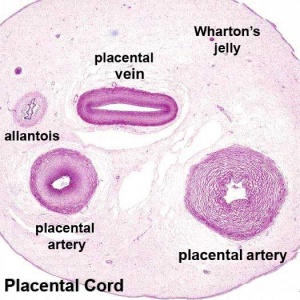2010 Lecture 8: Difference between revisions
(Created page with '=Placenta= == Introduction == 350px|left|fetal membranes and placenta This lecture is an introduction to the development and functions of the p…') |
No edit summary |
||
| Line 1: | Line 1: | ||
=Placenta= | =Placenta= | ||
<div style="background:#F5FFFA; border: 1px solid #CEF2E0; padding: 1em; margin: auto; width: 90%; float:left;"><div style="margin:0;background-color:#cef2e0;font-family:sans-serif;font-size:120%;font-weight:bold;border:1px solid #a3bfb1;text-align:left;color:#000;padding-left:0.4em;padding-top:0.2em;padding-bottom:0.2em;">Lecture Notice - Mark Hill</div>This online lecture page will contain the content required when attending the lecture. Currently this page is only a template and will be updated before the lecture (this notice removed when completed). Final lecture pages can also be printed out using the "printable version" lefthand menu.</div> | |||
== Introduction == | == Introduction == | ||
This lecture is an introduction to the development and functions of the placenta. | This lecture is an introduction to the development and functions of the placenta. | ||
The placenta (Greek, ''plakuos'' = flat cake) named on the basis of this organs appearance. The placenta a mateno-fetal organ which begins developing at implantation of the blastocyst and is delivered with the fetus at birth. Only recently have we begun to understand the many different functions this organ carries out in addition to its role in embryonic nutrition. This lecture follows on the concepts of cardiovascular development covered in the previous lecture. | The placenta (Greek, ''plakuos'' = flat cake) named on the basis of this organs appearance. The placenta a mateno-fetal organ which begins developing at implantation of the blastocyst and is delivered with the fetus at birth. Only recently have we begun to understand the many different functions this organ carries out in addition to its role in embryonic nutrition. This lecture follows on the concepts of cardiovascular development covered in the previous lecture. | ||
The placenta and placental blood at birth has recently been seen as a new source for stem cells in bone marrow replacement therapy in many diseases. (More? [http://embryology.med.unsw.edu.au/Notes/stemcell4.htm Stem Cells - Cord Blood]) | The placenta and placental blood at birth has recently been seen as a new source for stem cells in bone marrow replacement therapy in many diseases. (More? [http://embryology.med.unsw.edu.au/Notes/stemcell4.htm Stem Cells - Cord Blood]) | ||
{| | |||
| [[File:Placental membranes.jpg|350px|left|fetal membranes and placenta]] | |||
| [[File:Placental cord cross-section.jpg|thumb|Placental cord cross-section]] | |||
|} | |||
{{Template:2010ANAT2341}} | |||
Revision as of 10:30, 15 July 2010
Placenta
Introduction
This lecture is an introduction to the development and functions of the placenta.
The placenta (Greek, plakuos = flat cake) named on the basis of this organs appearance. The placenta a mateno-fetal organ which begins developing at implantation of the blastocyst and is delivered with the fetus at birth. Only recently have we begun to understand the many different functions this organ carries out in addition to its role in embryonic nutrition. This lecture follows on the concepts of cardiovascular development covered in the previous lecture.
The placenta and placental blood at birth has recently been seen as a new source for stem cells in bone marrow replacement therapy in many diseases. (More? Stem Cells - Cord Blood)
Glossary Links
- Glossary: A | B | C | D | E | F | G | H | I | J | K | L | M | N | O | P | Q | R | S | T | U | V | W | X | Y | Z | Numbers | Symbols | Term Link
Course Content 2010
Embryology Introduction | Cell Division/Fertilization | Lab 1 | Week 1&2 Development | Week 3 Development | Lab 2 | Mesoderm Development | Ectoderm, Early Neural, Neural Crest | Lab 3 | Early Vascular Development | Placenta | Lab 4 | Endoderm, Early Gastrointestinal | Respiratory Development | Lab 5 | Head Development | Neural Crest Development | Lab 6 | Musculoskeletal Development | Limb Development | Lab 7 | Kidney | Genital | Lab 8 | Sensory | Stem Cells | Stem Cells | Endocrine | Lab 10 | Late Vascular Development | Integumentary | Lab 11 | Birth, Postnatal | Revision | Lab 12 | Lecture Audio | Course Timetable
Cite this page: Hill, M.A. (2024, April 24) Embryology 2010 Lecture 8. Retrieved from https://embryology.med.unsw.edu.au/embryology/index.php/2010_Lecture_8
- © Dr Mark Hill 2024, UNSW Embryology ISBN: 978 0 7334 2609 4 - UNSW CRICOS Provider Code No. 00098G

